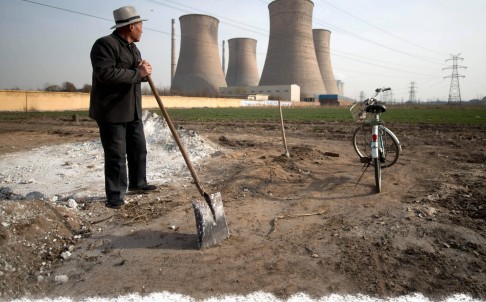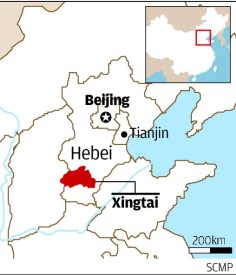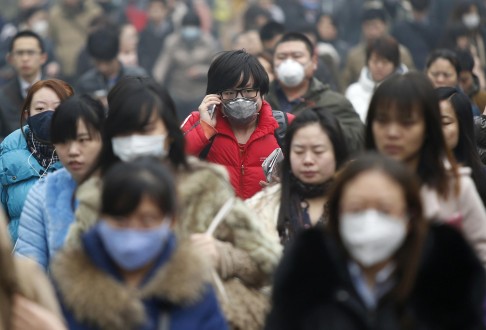- Joined
- Aug 23, 2014
- Messages
- 115
- Points
- 0
China's pollution data too hazy to know if leaders' war on smog is working
Many polluters are ignoring an edict to publish emissions details online, and numbers that are released are often incomplete, official study shows
PUBLISHED : Thursday, 18 September, 2014, 4:16am
UPDATED : Thursday, 18 September, 2014, 4:54am
Bloomberg

A power plant in Xingtai, Hebei, where average air quality has been the worst on the mainland for the past year. Photo: AFP
The mainland's efforts to name and shame its filthiest power stations and impose tough new emission standards are the leading weapons in President Xi Jinping's war on pollution. The world shouldn't hold its breath waiting for him to declare victory.
A coal-fired power plant in the centre of the nation's most polluted city appeared to shut down on June 30 when it stopped releasing its emissions data online a day before new standards came in.
Yet a large LCD screen outside the facility in Xingtai , in southern Hebei province, 360km south of Beijing, showed the plant was still partly operating. It was spewing fumes at almost three times the legal limit two days after the rules were introduced, according to a reading displayed on the screen.
Flaws are evident in the data across the country, with less than half the polluters in some provinces complying with a July 2013 edict from the Ministry of Environmental Protection to publish emissions data online, according to the ministry's own study. And the numbers that are released are often incomplete or show many plants continue to emit pollutants well above the maximum levels permitted, according to an examination of the data by Bloomberg News.
"We have good standards but it's always about implementation, what happens in the real world," said Huang Wei, a climate and energy campaigner for Greenpeace in Beijing.
The mainland's environment authorities at the local level "have very little power to eliminate these little plants", she said.

The problems evident in Xingtai, where average air quality has been the worst on the mainland for the past year, shows how difficult it will be for Xi to honour his promise to the world that the country will clean up its fossil fuel industry. It is the world's biggest emitter of greenhouse gases, fuelling global warming that the United Nations has warned may cause irreversible and widespread damage to the planet.
On the positive side, the Hebei Xingtai Power Generation plant where the LCD screen shows operations has closed two of its boilers, according to workers. The two remaining operational boilers have been equipped with equipment to filter nitrogen oxide so should meet the new standards, said Li Hongxin, the plant's manager for external communications.
The filters work through a process known as selective catalytic reduction that converts NOx - gases that can cause respiratory diseases - to less harmful chemicals. On a visit almost two months later, the screen showed another boiler was in operation, releasing emissions within the limit for nitrogen oxide.
"We're doing a lot to meet the environmental standard," Li said. "Without us, the sky would be even darker."
She declined to comment on why the firm's monitoring data was no longer released on the official website of the environment ministry.
China said in June that it was working on how to cap its emissions for the first time, as talks under the United Nations Framework Convention on Climate Change try to seal a post-2020 deal that applies to all. The country has pledged to cut carbon emissions per unit of economic output by as much as 45 per cent from 2005 levels before 2020.

Commuters protect themselves from the Beijing smog. China is the world's biggest emitter of greenhouse gases. Photo: Reuters
The goal is made harder by its reliance on coal. It already consumes about half of the world's supply and must meet power needs that will double by 2030, according to estimates from Bloomberg New Energy Finance. To tackle air that kills as many as half a million Chinese a year, power companies nationwide have been ordered to install equipment to bring harmful emissions down to a level similar to requirements in Europe and the US.
In the case of nitrogen oxide, equipment is needed on as much as 800 gigawatts of power plant capacity, or two-thirds of the nation's total, according to Zhou Xizhou, director of China Energy at HIS, a US consulting company.
"That itself is a huge undertaking that the world has never seen before, particularly with such a tight schedule," Zhou said. "When they announced the new rules two years ago and set a deadline for this year, we were very clear they were going to need more time. And there are all kinds of irregularities with enforcement that we've seen."
A two-and-a-half-year grace period before the new emissions standards were introduced on July 1 was supposed to give companies sufficient time to adapt. Yet data released by power producers in Hebei on August 29 showed 13 of 36 plants exceeded NOx limits, with one plant emitting 800 times the maximum of 100 milligrams per cubic metre and another reading 123,815 milligrams per cubic metre.
While some large plants show hourly data for emissions of NOx and sulphur dioxide, or SO {-2}, at each boiler, in many cases monitoring points do not give out any data, or report emissions as zero, according to the data on the website of the environmental bureau in Hebei, home to the nation's six most polluted cities. Users cannot access historical data for any power plant.
The release of real-time data to the public is at least a sign of progress, according to Ma Jun , a Beijing-based founder of the non-profit group the Institute of Public and Environmental Affairs. Ma set up a mobile phone app for the public to better access the data and flag violators.
They can share the data on Weibo and other social media platforms. Every hour there are about 300 to 400 emitters who do not comply with the standards in the provinces that release data, he said.
"There are some gaps in the quality of the data but I continue to believe that it's better to expose all this to public scrutiny," Ma said. "Without public scrutiny there is greater opportunity for manipulation."
In April, new laws were passed, effective from January 1, that allow for consecutive daily fines on polluters if they do not improve.
Data shared on Weibo in June showed a state- owned power plant in Linyi , 500km southeast of Xingtai, was regularly over the limits, prodding the city's environment bureau into action. It investigated and ordered the operator to bring forward plans to install new equipment, according to a notice on the bureau's official Weibo account.
While the mainland is moving its power plants out to more remote western parts of the country and building a series of ultra-high-voltage lines to bring the electricity back east, it still needs power closer to the major metropolises where most people live. The municipalities of Beijing and Tianjin , together with Hebei and Shandong provinces, consume the same amount of coal as all of Europe, according to Greenpeace.
Such a high political priority is placed by leaders on reducing pollution that it is becoming harder for power producers to ignore or fudge the new standards, IHS's Zhou said. Xi in June called for an "energy production and consumption revolution", to reduce emissions from coal plants.
Companies have become more sophisticated in manipulating data from monitoring equipment, Zou Shoumin, the head of the Ministry of Environment's monitoring division, said in August, according to China Radio International.
The ministry released a report stating the system was not effective in curbing emissions because real-time data was not good enough. The ministry vowed to "harshly punish" anyone who fabricated data.
Part of the problem is cost. Power operators receive a subsidy of 8 yuan (HK$10) a megawatt-hour for fitting equipment to control emissions of NOx versus the actual cost of 12 yuan to 15 yuan, according to the China Electricity Council.
"It's very expensive," said Wang Ping, who is in charge of equipment at a power plant in Shijiazhuang , Hebei. He drove up to see the emissions-control equipment at Hebei Xingtai Power Generation's new plant before purchasing his own.
Hebei province, which surrounds Beijing, is under pressure to reduce air pollution and has set itself a target to "basically end serious pollution days" by 2022, according to the official Hebei Daily. The closed power plants and steel factories that dot Xingtai are testimony to the province's efforts to cut coal production by 40 million tonnes by 2017 from 2012.
The downside is slowing provincial economic growth, with Hebei's pace of expansion falling to 5.8 per cent in the first half of 2014, down from 8.7 per cent a year earlier. That was the second-lowest growth of all provinces.
"You have to meet the country's standards," said a worker at Hebei Xingtai Power Generation's plant. He said his job was moving to the company's new facility on the city's outskirts, an hour's bus ride away, where a red and white chimney continuously billows smoke.
In a city where air quality is about 20 times worse than New York - measured by PM 2.5, the small particles that the World Health Organisation says pose the greatest risk to human health - even small victories are celebrated.
Xingtai's environment bureau called a special meeting after the city was not ranked the nation's most polluted city for the month of July.
Xingtai, which had been on top of the pollution list every month from January to June, was the second-most polluted, behind Tangshan in Hebei.
At the meeting, cadres were told to "overcome excessive pride and excitement" and to work more to ensure Xingtai stayed off the top of the list. The cadres were given a new goal: to become the nation's third most polluted city.
